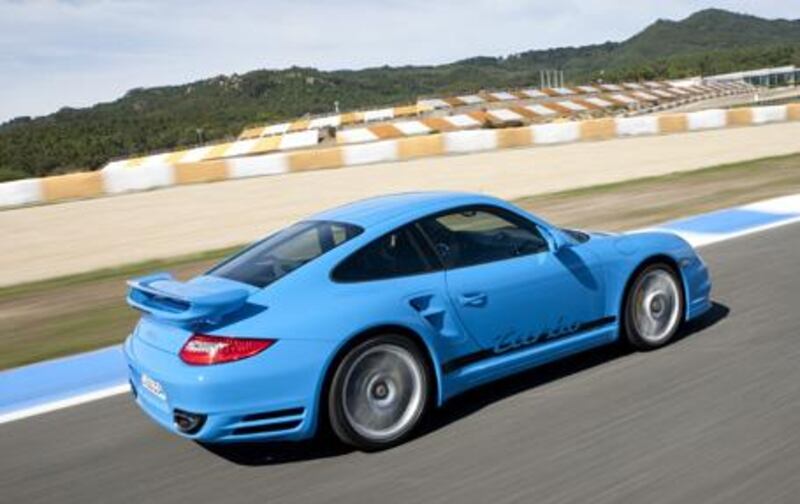LISBON, Portugal // For a boast to be effective, it always has to involve more. Larger, further, added, even the slightly-too-proper supplementary are the preferred adjectives. Lesser, fewer, insufficient are all descriptors best generally avoided. I suppose a microchip might be an exception, but in general, unless you are very, very nerdy, nobody boasts about their semiconductors.
Thus, the fact that Porsche now says that its all-new, much-improved 911 Turbo has less turbo-boost - 11.8psi versus 14.7 - doesn't, at least initially, sound like a good thing. Come to think of it, even on secondary inspection, it doesn't sound any better. Why on earth would you want less when more turbo-boost is such a good thing? The good news is that turbo-boost is one of the few things diminished in the new 911. Indeed, performance enthusiasts need not fret that the new 911 Turbo is lesser. Horsepower is up to 500 from 480, torque increases from 620Nm of torque to more than 650 and there are now seven speeds in its automatic (PDK) gearbox rather than five.
That's because the Turbo not only gets a boost in displacement, from 3.6-litres to 3.8L, but also because, like the other 911s in Porsche's lineup, it gets an all-new Direct Fuel Injection (DFI) system. For those unaware of the benefits of DFI, this new injection system dumps fuel directly into the combustion chamber rather than the intake manifold. One of the benefits is that the fuel remains cooler and also the combustion can be better controlled. The upshot of all this is that the compression ratio can be raised, sometimes by as much as a full point. This is especially beneficial for turbocharged engines which traditionally have had to make do with the lower compression (to prevent detonation, or pinging, at low speeds) that causes the dreaded turbo lag.
Being able to raise the compression ratio allows more compression, better response and, as well better fuel economy. A 2010 six-speed 911 Turbo, for instance, achieves almost 10 per cent better fuel economy - 11.6L/100 km versus 12.8 - compared with the outgoing model. Of course, what everyone really cares about is the new car's performance and here again the new Turbo boasts more. Porsche now boasts its top speed as 312kph and zero-to-100kph is officially rated at 3.4 seconds (though a German magazine has already tested it at 3.1) and sprints through the quarter mile in just 11.4 ticks of the stopwatch.
All those superlative figures, by the way, are achieved with Porsche's new PDK transmission. It may replace the Tiptronic as the "automatic" in the Turbo's lineup, but in reality, the PDK is a seven-speed, automatically-actuated, dual-clutch manual transmission. Having that seventh speed helps fuel economy by reducing revs at motorway speeds and because the extra ratios are more closely spaced, it helps acceleration too. But, what really enhances the Turbo's acceleration is its "launch control" mode. Getting a rapid start from an all-wheel-drive, turbocharged car is always tricky. Getting the revs right for optimum torque can be problematic, but getting the throttle/clutch combination so that the revs are kept constant but the AWD isn't overloaded (since it's impossible to break all four tyres loose, which actually reduces the load on the drivetrain) when you sidestep the clutch pedal is very difficult indeed.
Launch control solves this problem by letting the 911's onboard computer get to work. Push the "sport plus" button on the dash, depress the brake pedal while mashing the throttle and as soon as you lift your left foot, the 911 rockets ahead with the computer modulating both clutch and throttle. It's an impressive piece of kit: after releasing the brake, there's a momentary spinning of the rear tyres and then the 911 launches in a flurry of revs and automated changes gear.
The 911 Turbo - to the chagrin of a few - also has such automated gadgets to aid its handling. Besides the all-wheel-drive system that is almost mandatory to make all this torque - nearly 700Nm available in its 10-second "overboost" mode - manageable, there's also traction control and Porsche's version of an electronic safety nanny, Porsche Stability Management (PSM). This last is vastly improved over its predecessors, not intruding quite as early in proceedings as the original, overenthusiastic system. That means, for instance, that you can slide the rear end of the 911 semi-dramatically exiting any of the many decreasing radius hairpins that populate the famed Estoril race track in the south of Portugal.
Indeed, there's a lot more leeway - and therefore fun - in this latest version of PSM. Brake heavily, for instance, at the back end of the long back straight at Estoril and the back end of the 911 gets all light, the rear axle starting that gentle swaying that tells you that you've reached the limits, or at least my limits, of braking. The new Porsche Torque Vectoring (PTV) system also helps matters by braking the inside rear wheel any time it senses understeer. Purists may resist all these electronic additions, but truly they make the average - and even the experienced - driver much quicker around the race track.
And that's the last, but perhaps most impressive, of the betters. According to Porsche, all these goodies add up to the 2010 911 Turbo being 10 seconds faster around the famed Nürburgring circuit - 7:39 versus 7:49. That might not mean much to ordinary folks, but it surely is more. Much more.











